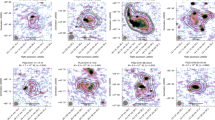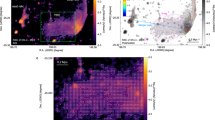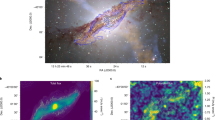Abstract
The Galactic magnetic field plays an important role in the evolution of the Galaxy, but its small-scale behaviour is still poorly known. It is not known whether the Galactic field permeates the halo of the Galaxy. By observing pulsars in the halo globular cluster 47 Tucanae, we have probed the Galactic magnetic field at arcsecond scales, discovering an unexpected large gradient in the component of the magnetic field parallel to the line of sight. This gradient is aligned with a direction perpendicular to the Galactic disk and could be explained by magnetic fields amplified to some 60 μG within the globular cluster. Such a scenario supports the existence of a magnetized outflow that extends from the Galactic disk to the halo and interacts with 47 Tucanae.
This is a preview of subscription content, access via your institution
Access options
Access Nature and 54 other Nature Portfolio journals
Get Nature+, our best-value online-access subscription
$29.99 / 30 days
cancel any time
Subscribe to this journal
Receive 12 digital issues and online access to articles
$119.00 per year
only $9.92 per issue
Buy this article
- Purchase on Springer Link
- Instant access to full article PDF
Prices may be subject to local taxes which are calculated during checkout




Similar content being viewed by others
Data availability
The data that support the plots within this paper and other findings of this study are available from the corresponding author upon reasonable request.
Code availability
The custom codes used for the analysis and described in the Methods are provided as Supplementary Software.
References
Gaensler, B. M., Beck, R. & Feretti, L. The origin and evolution of cosmic magnetism. New Astron. Rev. 48, 1003–1012 (2004).
Widrow, L. M. Origin of galactic and extragalactic magnetic fields. Rev. Mod. Phys. 74, 775–823 (2002).
Haverkorn, M., Brown, J. C., Gaensler, B. M. & McClure-Griffiths, N. M. The outer scale of turbulence in the magnetoionized galactic interstellar medium. Astrophys. J. 680, 362–370 (2008).
Haverkorn, M. & Heesen, V. Magnetic fields in galactic Haloes. Space Sci. Rev. 166, 133–144 (2012).
Han, J. Magnetic fields in our Galaxy: how much do we know? (II) Halo fields and the global field structure. In AIP Conference Proc. 609 Astrophysical Polarized Backgrounds (eds Cecchini, S. et al.) 96 (AIP, 2002).
Ferrière, K. & Terral, P. Analytical models of X-shape magnetic fields in galactic halos. Astron. Astrophys. 561, A100 (2014).
Shukurov, A. et al. A physical approach to modelling large-scale galactic magnetic fields. Astron. Astrophys. 623, A113 (2019).
Jansson, R. & Farrar, G. R. A new model of the galactic magnetic field. Astrophys. J. 757, 14 (2012).
Terral, P. & Ferrière, K. Constraints from Faraday rotation on the magnetic field structure in the galactic halo. Astron. Astrophys. 600, A29 (2017).
Unger, M. & Farrar, G. R. Uncertainties in the magnetic field of the Milky Way. In 35th International Cosmic Ray Conference 301, 558 (Proceedings of Science, 2017).
Tüllmann, R., Dettmar, R. J., Soida, M., Urbanik, M. & Rossa, J. The thermal and non-thermal gaseous halo of NGC 5775. Astron. Astrophys. 364, L36–L41 (2000).
Carretti, E. et al. Giant magnetized outflows from the centre of the Milky Way. Nature 493, 66–69 (2013).
Everett, J. E. et al. The Milky Way’s kiloparsec-scale wind: a hybrid cosmic-ray and thermally driven outflow. Astrophys. J. 674, 258–270 (2008).
Manchester, R. N. Pulsar rotation and dispersion measures and the galactic magnetic field. Astrophys. J. 172, 43–52 (1972).
Han, J. L., Manchester, R. N., Lyne, A. G., Qiao, G. J. & van Straten, W. Pulsar rotation measures and the large-scale structure of the galactic magnetic field. Astrophys. J. 642, 868–881 (2006).
Noutsos, A., Johnston, S., Kramer, M. & Karastergiou, A. New pulsar rotation measures and the Galactic magnetic field. Mon. Not. R. Astron. Soc. 386, 1881–1896 (2008).
Sobey, C. et al. Low-frequency Faraday rotation measures towards pulsars using LOFAR: probing the 3D Galactic halo magnetic field. Mon. Not. R. Astron. Soc. 484, 3646–3664 (2019).
Lorimer, D. & Kramer, M. Handbook of Pulsar Astronomy (Cambridge Univ. Press, 2005).
Mao, S. A. et al. A survey of extragalactic Faraday rotation at high galactic latitude: the vertical magnetic field of the Milky Way toward the galactic poles. Astrophys. J. 714, 1170–1186 (2010).
Schnitzeler, D. H. F. M. The latitude dependence of the rotation measures of NVSS sources. Mon. Not. R. Astron. Soc. 409, L99–L103 (2010).
Manchester, R. N., Lyne, A. G., D’Amico, N., Johnston, S. & Lim, J. A 5.75-millisecond pulsar in the globular cluster 47 Tucanae. Nature 345, 598–600 (1990).
Manchester, R. N. et al. Discovery of ten millisecond pulsars in the globular cluster 47 Tucanae. Nature 352, 219–221 (1991).
Robinson, C. et al. Millisecond pulsars in the globular cluster 47 Tucanae. Mon. Not. R. Astron. Soc. 274, 547–554 (1995).
Camilo, F., Lorimer, D. R., Freire, P. C. C., Lyne, A. G. & Manchester, R. N. Observations of 20 millisecond pulsars in 47 Tucanae at 20 centimeters. Astrophys. J. 535, 975–990 (2000).
Pan, Z. et al. Discovery of two new pulsars in 47 Tucanae (NGC 104). Mon. Not. R. Astron. Soc. 459, L26–L30 (2016).
Ridolfi, A. et al. Long-term observations of the pulsars in 47 Tucanae—I. A study of four elusive binary systems. Mon. Not. R. Astron. Soc. 462, 2918–2933 (2016).
Freire, P. C. C. et al. Long-term observations of the pulsars in 47 Tucanae—II. Proper motions, accelerations and jerks. Mon. Not. R. Astron. Soc. 471, 857–876 (2017).
Freire, P. C. C. et al. Detection of ionized gas in the globular cluster 47 Tucanae. Astrophys. J. 557, L105–L108 (2001).
Abbate, F. et al. Internal gas models and central black hole in 47 Tucanae using millisecond pulsars. Mon. Not. R. Astron. Soc. 481, 627–638 (2018).
McDonald, I. & Zijlstra, A. A. Globular cluster interstellar media: ionized and ejected by white dwarfs. Mon. Not. R. Astron. Soc. 446, 2226–2242 (2015).
Staveley-Smith, L. et al. The Parkes 21 CM multibeam receiver. Publ. Astron. Soc. Aus. 13, 243–248 (1996).
Armstrong, J. W., Rickett, B. J. & Spangler, S. R. Electron density power spectrum in the local interstellar medium. Astrophys. J. 443, 209–221 (1995).
Rybicki, G. B. & Lightman, A. P. Radiative Processes in Astrophysics (Wiley-Interscience, 1979)
Baumgardt, H., Hilker, M., Sollima, A. & Bellini, A. Mean proper motions, space orbits, and velocity dispersion profiles of galactic globular clusters derived from Gaia DR2 data. Mon. Not. R. Astron. Soc. 482, 5138–5155 (2019).
Mao, S. A. et al. Radio and optical polarization study of the magnetic field in the small magellanic cloud. Astrophys. J. 688, 1029–1049 (2008).
Oppermann, N. et al. Estimating extragalactic Faraday rotation. Astron. Astrophys. 575, A118 (2015).
Bailes, M. et al. MeerTime—the MeerKAT key science program on pulsar timing. In MeerKAT Science: On the Pathway to the SKA 277, 11 (Proceedings of Science, 2016)
Hotan, A. W., van Straten, W. & Manchester, R. N. PSRCHIVE and PSRFITS: an open approach to radio pulsar data storage and analysis. Publ. Astron. Soc. Aus. 21, 302–309 (2004).
van Straten, W., Demorest, P. & Oslowski, S. Pulsar data analysis with PSRCHIVE. Astron. Res. Technol. 9, 237–256 (2012).
van Straten, W. High-fidelity radio astronomical polarimetry using a millisecond pulsar as a polarized reference source. Astrophys. J. Suppl. 204, 13 (2013).
Tiburzi, C. et al. The high time resolution universe survey—IX. Polarimetry of long-period pulsars. Mon. Not. R. Astron. Soc. 436, 3557–3572 (2013).
Wardle, J. F. C. & Kronberg, P. P. The linear polarization of quasi-stellar radio sources at 3.71 and 11.1 centimeters. Astrophys. J. 194, 249–255 (1974).
Simmons, J. F. L. & Stewart, B. G. Point and interval estimation of the true unbiased degree of linear polarization in the presence of low signal-to-noise ratios. Astron. Astrophys. 142, 100–106 (1985).
Everett, J. E. & Weisberg, J. M. Emission beam geometry of selected pulsars derived from average pulse polarization data. Astrophys. J. 553, 341–357 (2001).
Naghizadeh-Khouei, J. & Clarke, D. On the statistical behaviour of the position angle of linear polarization. Astron. Astrophys. 274, 968 (1993).
Noutsos, A., Karastergiou, A., Kramer, M., Johnston, S. & Stappers, B. Phase-resolved Faraday rotation in pulsars. Mon. Not. R. Astron. Soc. 396, 1559–1572 (2009).
Dai, S. et al. A study of multifrequency polarization pulse profiles of millisecond pulsars. Mon. Not. R. Astron. Soc. 449, 3223–3262 (2015).
Brentjens, M. A. & de Bruyn, A. G. Faraday rotation measure synthesis. Astron. Astrophys. 441, 1217–1228 (2005).
Sun, X. H. et al. Comparison of algorithms for determination of rotation measure and Faraday structure. I. 1100-1400 MHz. Astron. J. 149, 60 (2015).
Tinbergen, J. Astronomical Polarimetry (Cambridge Univ. Press, 1996).
Yan, W. M. et al. Polarization observations of 20 millisecond pulsars. Mon. Not. R. Astron. Soc. 414, 2087–2100 (2011).
Foreman-Mackey, D., Hogg, D. W., Lang, D. & Goodman, J. emcee: The MCMC Hammer. Publ. Astron. Soc. Pac. 125, 306 (2013).
The Astropy Collaboration et al. Astropy: A community Python package for astronomy. Astron. Astrophys. 558, A33 (2013).
The Astropy Collaboration et al.The Astropy project: building an open-science project and status of the v2.0 core package. Astron. J. 156, 123 (2018).
Minter, A. H. & Spangler, S. R. Observation of turbulent fluctuations in the interstellar plasma density and magnetic field on spatial scales of 0.01 to 100 parsecs. Astrophys. J. 458, 194 (1996).
Chiuderi, C. & Velli, M. Basics of Plasma Astrophysics (Springer, 2015).
McLaughlin, D. E. et al. Hubble space telescope proper motions and stellar dynamics in the core of the globular cluster 47 Tucanae. Astrophys. J. Suppl. Ser. 166, 259–297 (2006).
Acknowledgements
We acknowledge the help of A. Jameson in performing the observations. We thank K. Liu, S. A. Mao and M. Kramer for useful comments. The Parkes radio telescope is part of the Australia Telescope, which is funded by the Commonwealth of Australia for operation as a National Facility managed by the Commonwealth Scientific and Industrial Research Organisation. We are indebted to the communities behind the multiple open-source software packages on which this work depended. This research made use of Astropy, a community-developed core Python package for Astronomy. F.A., A.P. and A.R. acknowledge support from the Ministero degli Affari Esteri della Cooperazione Internazionale–Direzione Generale per la Promozione del Sistema Paese–Progetto di Grande Rilevanza ZA18GR02. Part of this work has also been funded using resources from the research grant ‘iPeska’ (P.I. A.P.) funded under the INAF national call Prin-SKA/CTA approved with the Presidential Decree 70/2016. The authors acknowledge the support of J. Mack (STScI) and G. Piotto (University of Padova) in the creation of Fig. 2.
Author information
Authors and Affiliations
Contributions
F.A. calibrated the data, estimated the RM, created the magnetic field models, performed the statistical analysis and compiled the manuscript. A.P. conceived and supervised the project and revised the manuscript. C.T. helped in the calibration and RM estimation process and revised the manuscript. E.B. provided access to the data, pre-analysed the observations and revised the manuscript. W.v.S. provided crucial help in the polarization calibration process and revised the manuscript. A.R. and P.F. shared the latest timing results and revised the manuscript. A.R. also helped in the production of the polarization profiles shown in Supplementary Figs. 1–3.
Corresponding author
Ethics declarations
Competing interests
Authors declare no competing interests.
Additional information
Publisher’s note Springer Nature remains neutral with regard to jurisdictional claims in published maps and institutional affiliations.
Extended data
Extended Data Fig. 1 Diagram of the shock forming in front of the globular cluster.
The shock is cause by the superalfvenic motion of the cluster in the frame of the Galactic wind. The globular cluster (not to scale) is the dashed circle, the thick black line is the shock front and the blue lines are the magnetic field lines. The quantities denoted with the subscript 1 are the velocity, density and magnetic field of the gas in the upstream region, while the quantities denoted with the subscript 2 are the same in the downstream region. The density of the gas in the cluster is denoted by nGC.
Supplementary information
Supplementary Information
Supplementary Figs. 1–6.
Supplementary Software
Five Python scripts to perform various tasks, as described in the enclosed README.
Rights and permissions
About this article
Cite this article
Abbate, F., Possenti, A., Tiburzi, C. et al. Constraints on the magnetic field in the Galactic halo from globular cluster pulsars . Nat Astron 4, 704–710 (2020). https://doi.org/10.1038/s41550-020-1030-6
Received:
Accepted:
Published:
Issue Date:
DOI: https://doi.org/10.1038/s41550-020-1030-6



